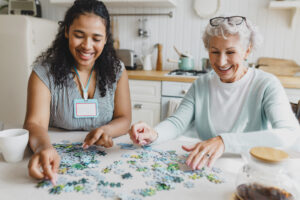Fresh air filling her lungs, feet pounding the pavement one stride at a time, Judy loved feeling a runner’s high more than anything. But, her running years had come to an unexpected halt when she’d been diagnosed with rheumatoid arthritis nearly a decade ago. Trying to manage her chronic pain made her scared of doing anything that might worsen her symptoms: she’d stopped her daily jogs and marathon training. And, without running as a stress release, she became sedentary and depressed as the pain worsened.
For many older adults, arthritis can too quickly become all-encompassing. It can create anxiety around doing physical activity, and prevent the sufferer from feeling able to enjoy their usual hobbies or exercises. If your aging loved one has been dealing with arthritis for some time, they may have shifted into a sedentary lifestyle, which can make the idea of physical activity feel even more daunting. Happily, taking a few small steps in the right direction—literally—can start to make a big difference. Not only will it improve your loved one’s mobility level, but it can do wonders to reduce the amount of pain they’re in—both physically and emotionally.
Low-Impact Exercises for Improving Flexibility, Balance, Cardio and Strength
The best way to approach pain management for arthritis is from all sides: doing a variety of low-impact activities that improve flexibility, cardio, strength, and balance will help your loved one feel relief from pain fastest. By starting slowly and gradually increasing the intensity of exercise, they’ll improve their physical fitness, and feel motivated to keep going. Beginning with some carefully chosen low-impact exercises can combat arthritis-induced pain while helping them once again love and be thankful for their bodies.
Exercises to Increase Flexibility
Stretching out muscles is especially important for arthritis sufferers whose joints tend to get stiffer than most, and who may go for longer periods of time between exercising. Fortunately, there are some basic stretches that can be very relaxing, gentle on the joints, and easy to do just about anywhere.
- Hanging stretch: Have your loved one stand up straight, then raise their arms slowly over their head. Gently fold the upper body (torso and arms) over the legs, so the hands dangle over the feet—or maybe just around the knees, depending on how flexible they are. Hold for a count of 10, then slowly draw the upper body back up to a regular standing position. Repeat three times.
- Quad stretch: Your loved one can stand with their feet shoulder-width apart, with one hand on the wall for balance. Pull the heel up toward the back of the thigh, grabbing the back of the foot with the other hand. Hold for 10 seconds and release. Change sides, repeating three times on each leg.
- Hatha yoga: Yoga can help your loved one reconnect with their body while giving it a great stretch. Depending on their preferences, consider picking up an instructional video for your loved one to do at home, or find classes for them to join at their local community center. Hatha yoga is naturally quite gentle and slow—all poses can be adjusted according to what your loved one’s body needs. If they take classes, be sure to notify the instructor about their arthritis so they can offer special instructions if needed.
Exercises to Improve Cardio and Strength
Doing low-impact cardio exercise and strength training will elevate your loved one’s mood, improve blood circulation and bone density, and help relieve arthritis-related pain. Avoid high-impact activities like running, and focus on low-impact ones like walking, swimming, or social dancing.
- Swimming: Gentle on joints, therapeutic, and fun to boot, water enables your loved one to work up a sweat by using their own body as resistance. Swimming laps, doing water aerobics, or water walking are all great cardio workouts. Find out if their community center offers classes for older adults or specific senior swim times to boost social interactions as well their heart rate.
- Dancing: Low-impact social dancing, free-form movement classes, or dance meditation offer an emotional release and an aerobic workout. Avoid dance styles that require certain body positions to be held for long periods of time, like ballroom dancing or ballet, or that are tough on joints, like tap dancing.
- Walking: Perhaps the simplest activity to start, your loved one can begin walking whenever they feel like it. Be sure they have a safe route that’s flat and easy to navigate. Tailor the walks for their activity level: keep them short and slow to begin with, then slowly increase the length and speed as your loved one improves.
- Strength training: Use light weights to do some gentle training, like arm raises and leg lifts. This can be done at home or at the gym. If using weights on land is too painful, move to a swimming pool to do resistance training in the water.
Exercises to Strengthen Balance
Arthritis can cause older adults to be more prone to falling, so improving balance is essential to prevent accidents. It can also help your loved one gain confidence in their ability to move with ease. There are many good balancing exercises to try that you can do either at home, at the gym, or in a class.
- Tai Chi: This mindful martial arts practice is wonderful for developing mental strength while improving the body’s natural balance. You can look for classes offered in your loved one’s area, get an instructional videotape, or find private teachers that come to the home.
- Meditative walking exercises: Practice heel-to-toe slow walking by emphasizing how the heel and toe meet the ground. Then, try walking backward for an extra challenge. Both of these can be done at home on slip-resistant flooring like carpet.
- Standing exercises: Balance by standing on one foot and holding for five counts. Then switch to the other foot, repeating for a total of 3 times on each leg. Next, try stepping side-to-side, lifting one foot off the ground for a count of 2, and then the other. This can be done in place on a slip-resistant surface.
Acknowledge and Embrace the Mind-Body Connection
Feeling afraid to move can have just as much of an impact on your loved one as the physical pain itself. Sometimes losing control of the body and being limited in movement can even cause your loved one to feel depressed. They might find themselves staying at home more often, not seeing their friends or family as much, and feeling unmotivated in general. Fortunately, caregivers can help inspire their aging loved ones to get their bodies moving by tackling some of the emotional components of this disease. By addressing the psychological stresses of living with arthritis, you can help your loved one feel ready to try some new exercises.
Talk to Your Loved One About Their Fears and Anxieties
Emotional resistance might be preventing your loved one from feeling motivated to exercise with arthritis. They might be struggling to come to terms with the fact that they can’t exert themselves the way they previously could. Speaking to your loved one can help them open up and accept their emotions surrounding arthritis.
- Have compassionate conversations: Chat with your loved one about how their arthritis is impacting them. Listen to their concerns and stresses regarding exercising more. Find out how they feel about their current level of activity, and where ideally they’d like to be in the future.
- Find out what their emotional barriers are: On an intellectual level, your loved one might know they should start exercising more—but emotions may be creating an obstacle. Perhaps they feel resentful of their condition and unwilling to put in extra effort to get back to where they used to be. Maybe they fear making their condition worse, or feel embarrassed about the pain they’re in. Sometimes just stating a fear out loud can help the person overcome it; other times caregivers may need to offer ongoing reassurance and support.
- Be mindful of their personality: During conversations, keep in mind the best ways to approach your loved one’s particular personality. If they tend to be shy or self-conscious, offer plenty of encouragement and maybe initiate community-based physical activities for them. If they’re more self-assured or a little stubborn, try to let them lead the way by making small suggestions then leaving it alone for a while. Finding the balance between being supportive, but not patronizing, can be tricky but is worth considering.
Set Reasonable Goals
Maybe your loved one hasn’t moved their body in several years, or perhaps they enjoy walking short distances, but not much else. Acknowledging where they’re at, and then starting out slowly, is essential to moving forward successfully. Especially if your loved one has been sedentary for some time, the transition may be slow—and that’s entirely okay. It’s less about racing to the finish line and more about taking one step at a time.
- Create a personalized plan: Start with scheduling in some time during their week to do some low-impact exercise. Start with whatever your loved one seems most enthusiastic about, whether it’s stretching, cardio, or balancing activities. Look for community classes if your loved one is extroverted, or search for good instructional videos if they prefer (or need) to stay at home.
- Be ready to adapt: For older adults with arthritis to engage in low-impact exercise over the long-term, they must feel free to adapt their routine according to their body’s needs. Take things slowly, and don’t be afraid to scale back any time they need to take a break. The goal isn’t to get to a certain level by a certain time, but rather to move forward slowly over the long-term.
- Offer to join them: Your loved one might appreciate company while doing their exercises, especially when they’re just getting started. You can also take this opportunity to offer encouragement, notice if they’re getting frustrated, and see if the level of exercise is too easy or intense for them.
Encourage Them to Notice Pain
The fear of increased pain and worsening their arthritis symptoms is usually what prevents people from exercising in the first place. And while this, of course, isn’t a reason to avoid exercise altogether, it’s equally important that your loved one be mindful of any pain they’re experiencing.
- Notice the type of pain: Being aware of the type of pain they feel when starting to exercise—or increasing their level of exercise—is critical to ensuring they’re not harming their body. Keep track of any pain that lasts several hours after exercising, or sharp, stabbing pain during it.
- Take a break: Feeling pain during exercise is usually a sign that your loved one is doing too much. Take a break, and then scale back on the intensity and amount. See if the pain decreases and, if it does, they can slowly get back to exercising.
- Keep open communication: Having regular conversations about your loved one’s pain level can help them notice changes, and remember to reduce or increase intensity as necessary. And you can always reach out to their doctor if you have any questions.
By approaching your aging loved one’s pain management for arthritis from two sides—both the physical and emotional aspects—you can help them feel better in their body and grow psychologically stronger too. As a caregiver, you can give your loved one empathy and compassion throughout their journey, offer them a safe space to share, and join them during exercises if they want company.
And not only can low-impact exercise reduce the amount of pain your loved one’s arthritis causes them, it can also help them better manage any other illnesses they may have, like diabetes or depression. They’ll grow more confident in their body’s ability to move despite their arthritis. Like many things, the toughest part is often just getting started—once your loved one breaks through that initial resistance and fear, they’ll soon see improvements, feel healthier, and be more motivated over the long-run.
If you’re unsure how to best support your aging loved one, Institute on Aging offers a range of programs, services, and online resources. Connect with us today to learn more.







